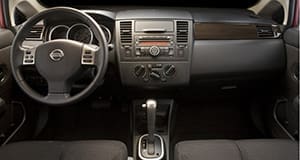
Because of its extra power, perhaps, the Versa didn’t feel as buzzy as a Honda Fit, for example, and those models equipped with the CVT and larger engine offered more than enough oomph to handle extra passengers and cargo
 Like a lot of people in my age group, I’m downsizing. That means – among other things – I’m looking for economical transport. Something that doesn’t take up too much space, offers decent storage, has a decent reliability record, is easy on gas and doesn’t cost a fortune.
Like a lot of people in my age group, I’m downsizing. That means – among other things – I’m looking for economical transport. Something that doesn’t take up too much space, offers decent storage, has a decent reliability record, is easy on gas and doesn’t cost a fortune.
And it has to be used.
So far I’ve discovered that models such as the Honda Fit, Toyota Yaris, and Volkswagen Golf don’t last long on the used car market.
And those that don’t sell quickly usually have crazy high mileage or are ‘rebuilt.’ This means they’ve been damaged and the repair bill exceeds the value of the car, so people buy them at auction and flip them after ‘fixing’ the damage themselves. Two words here: stay away.
I’ve narrowed my search down to several models, one of which is the Nissan Versa. I’m thinking five to 10 years old, with reasonable mileage and, hopefully, just one owner. Here’s a look at the 2010 Versa.
This was kind of a carryover year for the Versa. There were two body configurations: hatchback and sedan, with two engine choices, 1.6- and 1.8-litre four cylinders. Depending on the model, four transmissions were available: five- or six-speed manual, four-speed automatic, and continuously variable (CVT).
The CVT could feel ambiguous at certain speeds and when power was needed for overtaking, and didn’t kick down promptly like a conventional automatic transmission. It’s worth noting, however, that according to Natural Resources Canada’s fuel consumption guide, you would save $100 to $120 a year in fuel costs with the CVT compared to the manual six-speed version.
Arguably, the best engine choice was the larger of the two, which developed 122 horsepower and 127 foot-pounds of torque, making it one of the most powerful models in this market segment.

The back seats fold flat effortlessly, and there are various storage nooks and pockets throughout the car
Because of its extra power, perhaps, the Versa didn’t feel as buzzy as a Honda Fit, for example, and those models equipped with the CVT and larger engine offered more than enough oomph to handle extra passengers and cargo.
c. The five-door hatchback offered 1,427 litres of storage space with the back seat folded down, which was more than the Fit, and about on par with the likes of the Toyota Matrix, Golf or Mazda3 hatchback.
There’s one safety recall to report with Transport Canada, and it’s a minor assembly oversight that could cause the daytime running lights to malfunction. It’s easily corrected by dealers and not exactly life-threatening.
To this we can add a recall from National Highway Traffic Safety Administration (NHTSA) in the United States. It has to do with after-market Garmin GPS systems. Apparently, the batteries can overheat and lead to a fire. This is an extensive recall that affects a wide range of models and products.
NHTSA also had some 20 technical service bulletins on file for this vintage of the Versa, and they affect things like unco-operative power door locks, difficulties closing the rear hatch in cold weather, wonky front seat mechanisms and headlights that fog up.
For the most part, Consumer Reports liked the 2010 Versa. The climate control system and various power extras seem to be sketchy.
Comments to Consumer Reports from owners include:
- “Good on gas and easy to park.”
- “Seems underpowered.”
- “One of the most fun-to-drive vehicles I have ever owned.”
- “Would not hesitate to buy another Nissan product.”
A 2010 Versa seems to be in the $2,500 to $5,000 neighbourhood these days. The sedan version appears to be going for considerably less than the hatchback and the SL is roughly $1,000 pricier than the base S.
2010 Nissan Versa
Original base prices: $12,698 sedan, $14,198 hatchback
Engine: 1.6-litre or 1.8-litre four cylinder
Horsepower/torque: 107 and 122 hp/111 and 127 foot-pounds
Transmission: Five/six-speed manual, four-speed automatic, CVT
Fuel economy (litres/100 km): 7.3 city and 5.8 highway (CVT), with regular fuel
Some alternatives: Mazda3, Honda Fit, Toyota Yaris, Toyota Matrix, Kia Rondo, Volkswagen Golf.
Ted Laturnus writes for Troy Media’s Driver Seat Associate website. An automotive journalist since 1976, he has been named Canadian Automotive Journalist of the Year twice and is past-president of the Automotive Journalists Association of Canada (AJAC).
© Driver Seat
The views, opinions and positions expressed by columnists and contributors are the author’s alone. They do not inherently or expressly reflect the views, opinions and/or positions of our publication.

